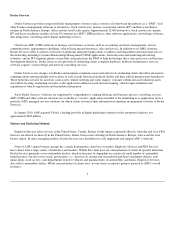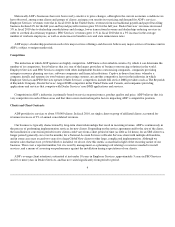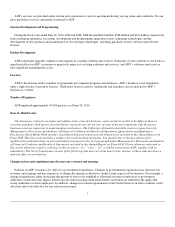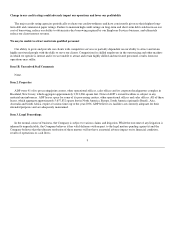ADP 2010 Annual Report Download - page 17
Download and view the complete annual report
Please find page 17 of the 2010 ADP annual report below. You can navigate through the pages in the report by either clicking on the pages listed below, or by using the keyword search tool below to find specific information within the annual report.
EXECUTIVE OVERVIEW
During the fiscal year ended June 30, 2010 (“
fiscal 2010
”
),
we maintained focus on the execution of our five
-
point strategic growth
program, which consists of:
●Strengthening the core business;
●Growing our differentiated HR Business Process Outsourcing (“
BPO
”
)
offerings;
●Focusing on international expansion;
●Entering adjacent markets that leverage the core; and
●Expanding pretax margins.
ADP
’
s fiscal 2010 was a challenging year and our results continued to be impacted by the economic downturn, including high
unemployment levels, record
-
low interest rates and volatile financial markets. However, as we look back over fiscal 2010, we were
pleased that ADP
’
s financial results were better than we initially anticipated. The economy showed signs of stabilization early on in
the fiscal year. Demand for ADP
’
s solutions increased and key business metrics, including Employer Services
’
sales, retention and
pays per control, began to improve during the second half of the year.
Consolidated revenues grew 1%, to $8,927.7 million in fiscal 2010, from $8,838.4 million in fiscal 2009, aided by fluctuations in foreign
currency rates, which increased revenues $68.2 million. In fiscal 2010, pretax earnings from continuing operations declined 2%, to
$1,863.2 million, net earnings from continuing operations declined 9%, to $1,207.3 million, and diluted earnings per share from
continuing operations decreased 8%, to $2.40, from $2.62 in fiscal 2009. Fiscal 2010 and fiscal 2009 included favorable tax items that
reduced the provision for income taxes by $12.2 million and $120.0 million, respectively. Excluding the favorable tax items from both
years, net earnings from continuing operations declined 1% and diluted earnings per share from continuing operations declined
slightly from $2.38 to $2.37.
Employer Services
’
revenues were flat in fiscal 2010. In the United States, revenues from our traditional payroll and payroll tax filing
business declined 4% for the full year and beyond payroll revenues grew 6% for the full year. “Pays per control,” which represents
the number of employees on our clients
’
payrolls as measured on a same
-
store
-
sales basis utilizing a subset of approximately 130,000
payrolls of small to large businesses that are reflective of a broad range of U.S. geographic regions, decreased 3.4% in fiscal 2010,
but were slightly positive in the fourth quarter of fiscal 2010 compared to the fourth quarter of fiscal 2009. Worldwide client retention
increased 0.4 percentage points as compared to the prior year. PEO Services
’
revenues grew 11% in fiscal 2010 due to a 5% increase
in the average number of worksite employees, as well as an increase in benefits costs and state unemployment insurance rates.
Employer Services
’
and PEO Services
’
worldwide new business sales, which represent annualized recurring revenues anticipated
from sales orders to new and existing clients, increased 4%, to just over $1 billion in fiscal 2010. Dealer Services
’
revenues decreased
3% in fiscal 2010 due to continued dealership consolidations and closings, lower transactional revenue and dealerships reducing
services in order to cut their discretionary expenses. Consolidated interest on funds held for clients declined 11%, or $67.0 million, to
$542.8 million. The decrease in the consolidated interest on funds held for clients resulted from the decrease in the average interest
rate earned to 3.6% in fiscal 2010 as compared to 4.0% in fiscal 2009. Average client funds balances increased slightly as a result of
wage growth and an increase in state unemployment insurance withholdings offset by the decline in pays per control.
We have a strong business model, which has approximately 90% recurring revenues, excellent margins from the ability to generate
consistent, healthy cash flows, strong client retention and low capital expenditure requirements. Additionally, ADP has continued to
return excess cash to our shareholders. In the last five fiscal years, we have reduced the Company
’
s common stock outstanding by
approximately 15% through share buybacks, partially offset by common stock issued under employee stock
-
based compensation
programs. We have also raised the dividend payout per share for 35 consecutive years.
15
























